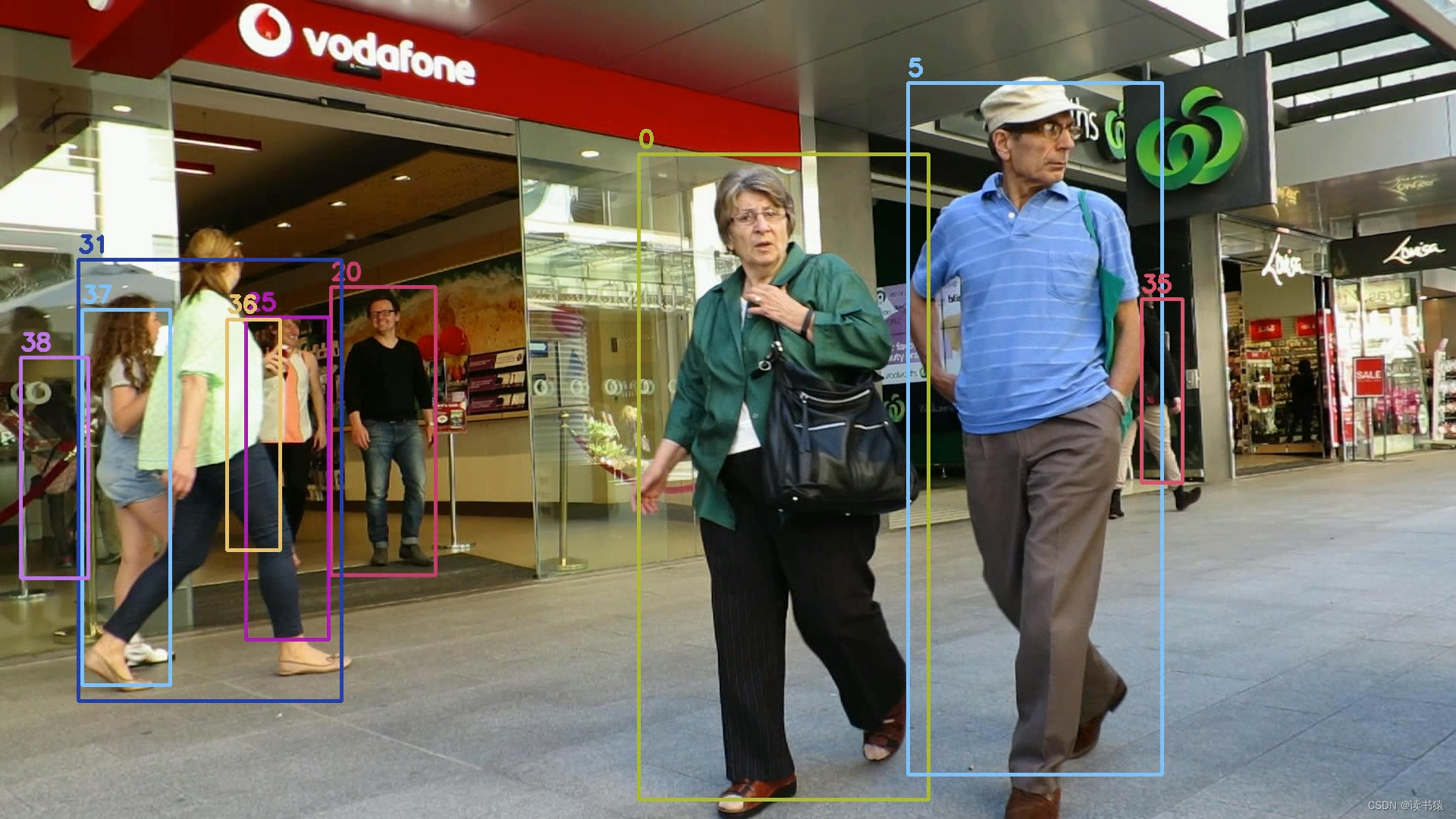【目标跟踪】多目标跟踪sort (python 代码)
前言
- 多目标跟踪 sort(Simple Online Realtime Tracking)是一种基于目标检测的跟踪。
- 根据我自己的理解把它分为个5步骤。
- 初始化航迹。当第一帧检测结果输入时,此时航迹(trackers)为空,此时航迹保存检测结果。等待下一帧检测结果输入。
- 预测。如果航迹不为空,航迹会预测一个 predict_box。
- 匹配。预测的一个predict_box 与此时进来的检测结果 detect_box 匈牙利匹配(代码计算的iou)。
- 更新。匹配成功的目标,用 detect_box 去修正 predict_box。未匹配成功的目标,重新起航迹或者舍弃。
- 输出结果,等待下一帧检测目标进来重复步骤 2,3,4。
- 对于算法细节这里不进行赘述。感兴趣可以参考博主往期博客。【目标跟踪】匈牙利算法 【目标跟踪】卡尔曼滤波(公式推导与代码)
- 想要 c++ 代码的朋友可以私信我交流。或者下一次写一篇,如果有机会的话(鬼脸jpg)。
python代码(带注释)
- 代码输入:1、连续帧图片,2、每帧图片的检测结果。(需要数据的可以私信我)
- 代码参考:git地址
- 输出结果以视频形式保存

main.py文件
import os
import numpy as np
import cv2
from filterpy.kalman import KalmanFilter
def linear_assignment(cost_matrix):
try:
import lap
_, x, y = lap.lapjv(cost_matrix, extend_cost=True)
return np.array([[y[i], i] for i in x if i >= 0]) #
except ImportError:
from scipy.optimize import linear_sum_assignment
x, y = linear_sum_assignment(cost_matrix)
return np.array(list(zip(x, y)))
def iou_batch(bb_test, bb_gt):
bb_gt = np.expand_dims(bb_gt, 0)
bb_test = np.expand_dims(bb_test, 1)
xx1 = np.maximum(bb_test[..., 0], bb_gt[..., 0])
yy1 = np.maximum(bb_test[..., 1], bb_gt[..., 1])
xx2 = np.minimum(bb_test[..., 2], bb_gt[..., 2])
yy2 = np.minimum(bb_test[..., 3], bb_gt[..., 3])
w = np.maximum(0., xx2 - xx1)
h = np.maximum(0., yy2 - yy1)
wh = w * h
o = wh / ((bb_test[..., 2] - bb_test[..., 0]) * (bb_test[..., 3] - bb_test[..., 1])
+ (bb_gt[..., 2] - bb_gt[..., 0]) * (bb_gt[..., 3] - bb_gt[..., 1]) - wh)
return (o)
def convert_bbox_to_z(bbox):
w = bbox[2] - bbox[0]
h = bbox[3] - bbox[1]
x = bbox[0] + w / 2.
y = bbox[1] + h / 2.
s = w * h
r = w / float(h)
return np.array([x, y, s, r]).reshape((4, 1))
def convert_x_to_bbox(x, score=None):
w = np.sqrt(x[2] * x[3])
h = x[2] / w
if (score == None):
return np.array([x[0] - w / 2., x[1] - h / 2., x[0] + w / 2., x[1] + h / 2.]).reshape((1, 4))
else:
return np.array([x[0] - w / 2., x[1] - h / 2., x[0] + w / 2., x[1] + h / 2., score]).reshape((1, 5))
class KalmanBoxTracker(object):
count = 0
def __init__(self, bbox):
self.kf = KalmanFilter(dim_x=7, dim_z=4)
# [center_x, center_y, s, r, center_x', center_y', s'] s = w * h r = w / h bbox 宽高比保持不变
self.kf.F = np.array(
[[1, 0, 0, 0, 1, 0, 0],
[0, 1, 0, 0, 0, 1, 0],
[0, 0, 1, 0, 0, 0, 1],
[0, 0, 0, 1, 0, 0, 0],
[0, 0, 0, 0, 1, 0, 0],
[0, 0, 0, 0, 0, 1, 0],
[0, 0, 0, 0, 0, 0, 1]])
self.kf.H = np.array(
[[1, 0, 0, 0, 0, 0, 0], [0, 1, 0, 0, 0, 0, 0], [0, 0, 1, 0, 0, 0, 0], [0, 0, 0, 1, 0, 0, 0]])
self.kf.R[2:, 2:] *= 10.
self.kf.P[4:, 4:] *= 1000.
self.kf.P *= 10.
self.kf.Q[-1, -1] *= 0.01
self.kf.Q[4:, 4:] *= 0.01
self.kf.x[:4] = convert_bbox_to_z(bbox)
self.time_since_update = 0
self.id = KalmanBoxTracker.count
KalmanBoxTracker.count += 1
self.history = []
self.hits = 0
self.hit_streak = 0
self.age = 0
def update(self, bbox):
self.time_since_update = 0
self.history = []
self.hits += 1
self.hit_streak += 1
self.kf.update(convert_bbox_to_z(bbox))
def predict(self):
if ((self.kf.x[6] + self.kf.x[2]) <= 0):
self.kf.x[6] *= 0.0
self.kf.predict()
self.age += 1
if (self.time_since_update > 0):
self.hit_streak = 0
self.time_since_update += 1
self.history.append(convert_x_to_bbox(self.kf.x))
return self.history[-1]
def get_state(self):
return convert_x_to_bbox(self.kf.x)
def associate_detections_to_trackers(detections, trackers, iou_threshold=0.3):
if (len(trackers) == 0):
return np.empty((0, 2), dtype=int), np.arange(len(detections)), np.empty((0, 5), dtype=int)
iou_matrix = iou_batch(detections, trackers)
if min(iou_matrix.shape) > 0:
a = (iou_matrix > iou_threshold).astype(np.int32)
if a.sum(1).max() == 1 and a.sum(0).max() == 1:
matched_indices = np.stack(np.where(a), axis=1)
else:
matched_indices = linear_assignment(-iou_matrix)
else:
matched_indices = np.empty(shape=(0, 2))
unmatched_detections = []
for d, det in enumerate(detections):
if (d not in matched_indices[:, 0]):
unmatched_detections.append(d)
unmatched_trackers = []
for t, trk in enumerate(trackers):
if (t not in matched_indices[:, 1]):
unmatched_trackers.append(t)
matches = []
for m in matched_indices:
if (iou_matrix[m[0], m[1]] < iou_threshold):
unmatched_detections.append(m[0])
unmatched_trackers.append(m[1])
else:
matches.append(m.reshape(1, 2))
if (len(matches) == 0):
matches = np.empty((0, 2), dtype=int)
else:
matches = np.concatenate(matches, axis=0)
return matches, np.array(unmatched_detections), np.array(unmatched_trackers)
class Sort(object):
def __init__(self, max_age=1, min_hits=3, iou_threshold=0.3):
self.max_age = max_age
self.min_hits = min_hits
self.iou_threshold = iou_threshold
self.trackers = []
self.frame_count = 0
def update(self, dets=np.empty((0, 5))):
self.frame_count += 1
# 根据上一帧航迹的框 预测当前帧的框.
trks = np.zeros((len(self.trackers), 5))
to_del = []
ret = []
for t, trk in enumerate(trks):
pos = self.trackers[t].predict()[0]
trk[:] = [pos[0], pos[1], pos[2], pos[3], 0]
if np.any(np.isnan(pos)):
to_del.append(t)
trks = np.ma.compress_rows(np.ma.masked_invalid(trks))
for t in reversed(to_del):
self.trackers.pop(t)
# 匈牙利匹配 上一帧预测框与当前帧检测框进行 iou 匹配
matched, unmatched_dets, unmatched_trks = associate_detections_to_trackers(dets, trks, self.iou_threshold)
# 如果匹配上 则更新修正当前检测框
for m in matched:
self.trackers[m[1]].update(dets[m[0], :])
# 如果检测框未匹配上,则当作新目标,新起航迹
for i in unmatched_dets:
trk = KalmanBoxTracker(dets[i, :])
self.trackers.append(trk)
i = len(self.trackers)
for trk in reversed(self.trackers):
d = trk.get_state()[0]
if (trk.time_since_update < 1) and (trk.hit_streak >= self.min_hits or self.frame_count <= self.min_hits):
ret.append(np.concatenate((d, [trk.id + 1])).reshape(1, -1))
i -= 1
# 如果超过self.max_age(3)帧都没有匹配上,则应该去除这个航迹
if (trk.time_since_update > self.max_age):
self.trackers.pop(i)
if (len(ret) > 0):
return np.concatenate(ret)
return np.empty((0, 5))
if __name__ == '__main__':
display, video_save = True, True # 是否show,结果是否存视频
max_age, min_hits, iou_threshold = 3, 3, 0.3 # sort算法参数
colours = 255 * np.random.rand(32, 3) # 随机生产颜色
video = cv2.VideoWriter("video.mp4", cv2.VideoWriter_fourcc('m', 'p', '4', 'v'), 10,
(1920, 1080)) if video_save else None
mot_tracker = Sort(max_age=max_age, min_hits=min_hits, iou_threshold=iou_threshold) # 创建sort跟踪器
seq_dets = np.loadtxt("det.txt", delimiter=',') # 加载检测txt结果
for frame in range(int(seq_dets[:, 0].max())):
frame += 1 # 从1帧开始
dets = seq_dets[seq_dets[:, 0] == frame, 2:7]
dets[:, 2:4] += dets[:, 0:2] # [x1,y1,w,h] to [x1,y1,x2,y2] 左上角x1,y1,w,h ——>左上角x1,y1,右下角x2,y2
mot_tracker.update(dets) # kalman 预测与更新
trackers = mot_tracker.trackers
image_path = os.path.join(".\\img", '%06d.jpg' % (frame)) # 图片路径
image = cv2.imread(image_path)
for d in trackers:
x1, y1, w, h = d.get_state()[0] # 获取 当前目标框状态
id = d.id
color = colours[int(id) % 32, :]
color = (int(color[0]), int(color[1]), int(color[2]))
cv2.rectangle(image, (int(x1), int(y1)), (int(w), int(h)), color, 3) # 画框
cv2.putText(image, str(int(id)), (int(x1), int(y1) - 10), cv2.FONT_HERSHEY_SIMPLEX, 1,
color, 3) # 画id
if display:
cv2.namedWindow("show")
cv2.imshow("show", image)
cv2.waitKey(0)
if video_save:
video.write(image)算法分析
- 优点:速度,快,很快,非常快。1s可以处理超过1000帧检测结果。
- 缺点:对于遮挡、以及非线性运动的物体(加减速或者转弯)跟踪效果差
- 优化方向:优化方式有很多,下次再写博客分享,如果有机会的话鬼脸.jpg。
本文参与 腾讯云自媒体同步曝光计划,分享自作者个人站点/博客。
原始发表:2023-11-13,如有侵权请联系 cloudcommunity@tencent.com 删除
评论
登录后参与评论
推荐阅读
目录
